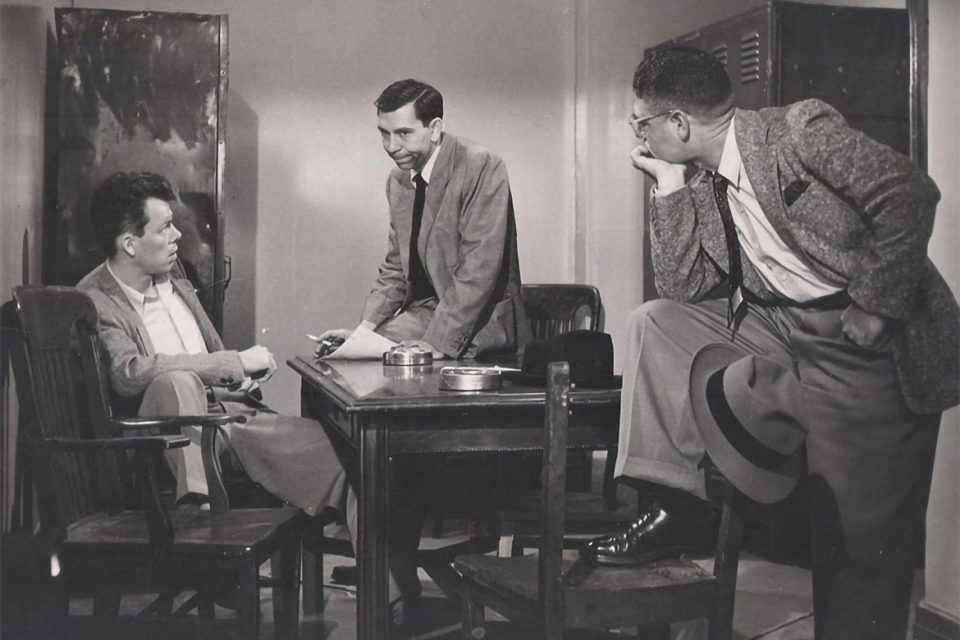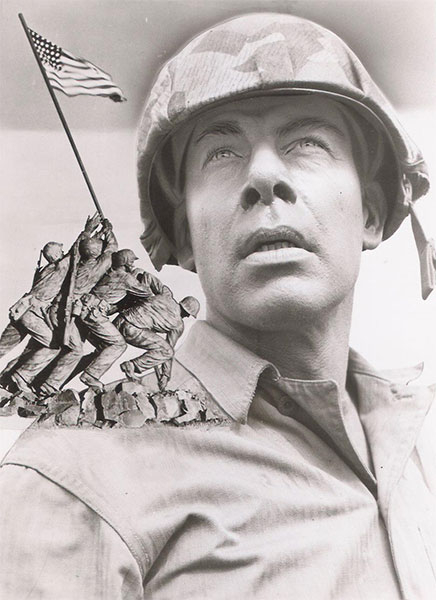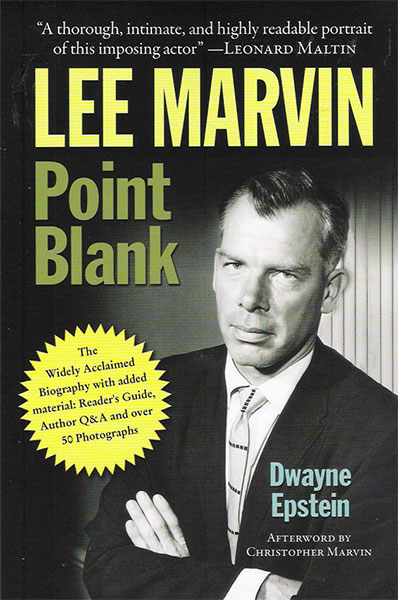February 19th marks the 95th birthday of movie legend Lee Marvin.
However, despite his mid-life cinematic superstardom, it was the medium of television that provided some of the most versatile and realistic performances of his career.
Marvin's foray in television occurred while he was still working in New York, in such early shows as T-Men In Action, Suspense, and other holdovers from the radio era. Many were aired live, resulting in infamous gaffes that have become the stuff of legend.
Eddie Albert remembered working with Marvin on a western episode of an anthology show in 1953. The actors had rehearsed diligently for more than a week on a climactic fight scene at a nearby gym on 57th Street. Despite the preparation, when the show aired, things went slightly awry:
"The fight was supposed to last about four minutes, but went for seven minutes on screen, which is a long time for such a physical workout," recalled Albert. "We had some furniture in that room. It was real furniture, heavy furniture. Since we weren't supposed to hit each other with it, the furniture was not breakaway.
"I think we did about four minutes, and were still fighting when he picked up this big table. Well, it happened because he took it easy with me to give me a chance to duck, but it hit the floor and fell the wrong way. It caught my leg underneath, and I couldn't get up to fight anymore.
"Remember that this went out live, and I was supposed to win the fight! He jumped on me with his back to the camera and wriggled me so I could get out, and we went for four minutes on that thing. We were so tired, we'd hit each other and then pick each other up. It was a wonderful battle. I have nothing but the highest respect for him as an actor because of that."
When Marvin was cast as a health food fanatic accused of homicide on a 1952 episode of Dragnet. Jack Webb, the show's creator and star, was equally impressed. He told an interviewer in 1969, "The episode Lee was on was a three-man piece, and we did a number of those in the beginning.
"In the conclusion of the story, Lee said he'd confess to everything if we bought him lunch. Well, the prop man needed something to substitute for food that could be photographed, so he got some plums. The prop man forgot to take the pits out and Lee was such a trouper, he never spit them out.
"Lee kept eating the plums during the scene until we forgot to tell him, we couldn't hear his dialogue. He stored them in his cheeks like a squirrel so the audience wouldn't know they were plums, and kept doing the scene."
In spite of such unplanned gaffes, Marvin still managed to have fun within the confines of the small screen. Veteran actress Beverly Garland remembers appearing with the actor on the 1955 pilot of the popular Richard Boone series, Medic. It was a somber tale of newlyweds, in which the pregnant wife was dying of leukemia.
Filmed at a real hospital, Garland wore a very believable prosthetic to make her look eight months' pregnant.
"We would walk down the hall to go to the cafeteria, all these people are coming in and out," recalled Garland. "Lee would go, 'Pow!' He'd hit me in the stomach and I'd go, 'Arrgh!' People would say, 'My God, did you see what that man did to his wife?' I'd say, 'Lee, you've got to stop doing this.' He thought it was the best thing that ever happened. I thought somebody was going to lynch the man."
Veteran TV director Leslie Martinson directed Lee Marvin in one of the actor's most offbeat TV anthology episodes. "How Charlie Faust Won a Pennant for the Giants" was a 30-minute episode of TV Reader's Digest that aired April 1955, and, according to Martinson, "The truth is it was Lee Marvin's show. He was just tailor-made for the part of Charlie Faust."
It told the 1911 baseball legend of a not-too-bright big league pitcher who never played the game, but was considered by manager John McGraw a good luck charm just by being in the dugout.
"He was simply great," Martinson said of Marvin's performance. "In comedy, he had a built-in thermostat to his humor. Some comedians don't, and would go over the top, but Lee instinctively knew what his limit was. When you encounter a performer who doesn't [have a built-in thermostat], that's when you need a strong director."
Marvin's film appearances had yet to take advantage of his comic timing, but television certainly did. On a 1961 episode of General Electric Theatre titled "The Joke's On Me," the actor played a cynical nightclub comic opposite comedy legend Bud Abbott as his long-suffering agent.
Marvin's delivery of his standup material in the beginning and end of the show's otherwise pedestrian plot is executed with razor sharp timing and gestures that lead one to wonder why he was not allowed to do more comedy in his career.
One of the best and least known of Lee Marvin's TV performances was in an episode of Studio One that aired in 1955. Directed by future Oscar-winner Franklin Schaffner, "Shakedown Cruise" costarred Richard Kiley, Don Gordon, and Walter Matthau.
Marvin played Lt. Mark Peele, the executive officer of a submarine that desperately wants his own command, and says as much to Captain Kiley who is about to transfer. During a routine assignment, the torpedo room floods, and the lives of 50 men are now at risk. Peele shows his true colors during the crisis and becomes unhinged, shouting, "I've sunk in one of these things before!"
The live show was a remarkable example of the dramatic capabilities of television: the creation of a premise in which tension can be built through plot and characters in a claustrophobic setting. "In those days I did a lot of Studio One, recalled Don Gordon. "I did one or two a month in those days, and it was hard work.
"You would rehearse for about 10 to 12 days, and then go out there live. The next day, you'd be walking around New York and all the cab drivers would say, 'Hey, I saw you last night in that show, and you were great.' So the reaction was immediate. Cab drivers are the best that way. They wouldn't have any problem saying, 'Hey I saw you last night, and you stink!' I love New York cab drivers."
By the late 1950s, when Lee Marvin's film career had reached a plateau of portraying brutal bad guys and interesting second leads, the actor reconsidered the idea of a series. "Everybody knew me, but nobody knew my name," he later said. "Every young actor should do a TV series to establish himself. That's the only way you can stand out from the crowd."
The program he chose was M Squad and, as was the custom, it first aired as a pilot during an anthology series, in this case, Schlitz Playhouse. What sold the American Tobacco Company sponsor on Marvin was the way in which the actor handled his four-pack-a-day cigarette habit. "That kid really smokes," noted one admiring executive.
M Squad premiered in September 1957 on NBC with Marvin as Lt. Frank Ballinger, detective of a special detail of the Chicago Police Department called in to handle difficult cases. The only other regular cast member was Paul Newlan as Ballinger's boss, Captain Grey.
Marvin described Ballinger's bristle-haired, .38-wielding detective as "No broads, no mother, no sleep, no eat, just a dumb fair cop."
The show was done in the popular procedural style of Dragnet, with Marvin providing voice-over narration as he hunted down his prey in each week's 30-minute episode. M Squad did fairly well in the ratings, and Marvin smoothly made the transition from movie heavy to TV hero. Keeping the show fresh, even after just a few episodes, proved a challenge to Marvin.
Frequent costar and fellow movie bad guy John Dennis noted the way in which Marvin kept the proceedings from becoming mundane. "You never quite knew what he was going to do," recalled Dennis. "Lee was a very challenging actor to work with because he really made you watch the little things that were happening. You'd watch that twinkle in his eyes when there should be no twinkle."
The last episode of M Squad aired June 28, 1960, and by that time live TV and anthology shows had faded, replaced by character-driven series. Marvin still found suitable work guest-starring in episodes of Wagon Train, The Untouchables, Dr. Kildare, Bonanza, Combat!, The Virginian and other popular series.
A Twilight Zone episode (the last and most enduring of all the anthology shows), penned by cult writer Richard Matheson, titled "Steel" would be proclaimed as the writer's favorite of all his episodes. It later became the basis for the 2011 Hugh Jackman feature, Real Steel.
Not all of Lee Marvin's TV work was episodic. In early 1960, he gave one of his most poignant performances in the dramatic special The American, directed by John Frankenheimer. He portrayed Native-American Ira Hayes who, as a Marine, helped raise the flag on Iwo Jima, but, as a civilian, died an alcoholic.
Unlike his film roles up to that time, Marvin was able to convey with amazing restraint the postwar guilt and trauma he was still grappling with himself. The performance remains one of the most realistic and heart-wrenching he would give.
Marvin said at the time, "He [Frankenheimer] called me, outlined the story, and asked if I'd like to play the role. I said, 'Yeah,' because I sympathized so much with Hayes. You know he never could escape being a hero. He was buried at Arlington."
The following year, the actor again played a psychologically tortured soldier in a special titled People Need People. Based on the true story of Dr. Harry Willner, who introduced the idea of group therapy to traumatized veterans, Marvin played an emotionally unreachable and violent Marine as therapist Willner, played by Arthur Kennedy, forces him to confront his demons.
The harrowing performance earned the actor his only Emmy nomination. It's worth noting that despite all the military-themed films Marvin made in his career, he never played a member of the USMC on screen as he was in real-life. That distinction existed solely on television.
Marvin made friends with the real Willner during the show, and even helped him stage the story for inmates at San Quentin the next year. "The prisoners and I hit it off without any trouble. One of them came up to me and said he didn't think of me as an actor, but as one of them. It was a great compliment—I think," joked Marvin.
The project Marvin started just one day prior to President Kennedy's assassination was a remake of Ernest Hemingway's short story, The Killers. It was to be the first movie made directly for television and, for the first time in his career, Lee Marvin was top-billed as an aging hitman, costarring with Clu Gulager as his protégé.
As the title characters searching for the reason why their target, John Cassavetes, gives up without a fight, they encounter a tangled history involving femme fatale, Angie Dickinson, and in his last acting performance before switching to politics, mobster Ronald Reagan.
"Movies went to TV from the theaters until The Killers," stated Dickinson. "It was MCA's Lew Wasserman who said, 'Hey guys, how about making movies that go right to television?' That was the genius of Lew Wasserman.
"It was a low-budget movie that looks like a B movie because it is a B movie. But it was made as a TV-movie for people who don't realize the production qualities are vastly different than they are for a good movie. That's why it has that look of it, of cheap. And yet, it's very good."
The project was directed by the versatile Don Siegel with an impressive supporting cast that included Claude Akins, Norman Fell, Bob Phillips, and Virginia Christine, the production shut down for a day of mourning before resuming what would be one of the seminal projects in Lee Marvin's career.
Clu Gulager appeared in practically every scene with Marvin and states emphatically, "He was, in my view, one of the foremost actors of his time. You never know about actors in their formative stages. Lee formed fairly early on and became a great actor, fairly early.
"Whereas an actor like Paul Newman, for example, became a great actor in his older age. I think Marty Landau did also. You never know. But Marvin was... by way of contrast, we all have our time."
Following the President's death, NBC executives deemed The Killers too violent for television, and instead released it in theaters in 1964 where it became a financial gold mine. When it played in England, Marvin won the British Academy Award for Best Foreign Film Actor, for a film that was made for television.
To purchase Dwayne Epstein's book, Lee Marvin: Point Blank, click here.









